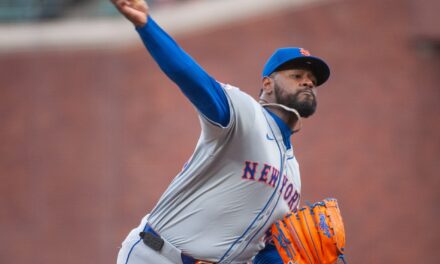
Spring Training draws ever so closer and it won’t be long until we start hearing those bats cracking and leather popping again in anticipation of a new season. There are many rites of passage associated with the arrival of Spring Training.
In addition to a litany of anecdotes from players who say they are in the best shape of their lives, and MLB managers emphatically asserting they are going to crack down on fundamentals, you can always rely upon Sports Illustrated’s Tom Verducci to pen an article touting his long-defunct “Year-After Effect” – better known as the Verducci Effect.
And among this year’s top five pitchers at risk of injury, Verducci lists Mets right-hander Noah Syndergaard.
“With all the attention last year on an innings limit for Mets teammate Matt Harvey, Syndergaard made a riskier jump in workload with a fraction of the fuss. The 23-year-old Syndergaard is four years younger than Harvey and had never before pitched a sixth month in a season, never mind the seventh that he did last year as New York advanced to the World Series. In that seventh month (October), Syndergaard threw 19 high-stress innings, including a 101-pitch start in the NLCS on two days of rest from a 17-pitch relief outing in the NLDS clincher. He also threw far more sliders in September and October.”
I know there are a lot of fans out there that totally buy into this Year After Effect, but over the years there has been plenty of evidence that randomness is as better a predictor of injuries than this theory Verducci still holds tight to.
As most astute observers will tell you, one of the indicators that something might be amiss with a young pitcher is a sudden (or gradual) loss of velocity on their fastball. And Verducci himself knows that and even pointed out that Syndergaard’s velocity increased in the postseason – his seventh month on the mound – and the fastest pitch he threw all year clocked in at 101.3 mph against the Los Angeles Dodgers in the NLDS.
Am I advocating that Syndergaard is invulnerable and won’t succumb to any arm injury this year or next? Of course not. All I’m saying is that you can’t use a mathematical formula to predict an injury, and that there are a lot of other external forces at play that affect the dynamics of such a flawed predictive process.
The odds of any pitcher who throws more than 98 mph are greater for an elbow injury than those who rely on less velocity. The increase in Tommy John surgeries are mostly tied to the increase in average fastball velocity, and nobody disputes that.
In other words, Jeurys Familia and any of the other Mets’ hard-throwers have as much of a chance of succumbing to injury this season as Noah Syndergaard.
But what’s important to note is the critical importance the Mets place on protecting their pitchers – so much so that just last week – GM Sandy Alderson said that the six-man rotation and skipped starts would be in play during the first half of the season.
This is intended to reduce stress on those young arms, keep them fresh and strong, and allow them to pitch deep into October. Look no further than Matt Harvey – who thanks to the Mets’ handling of him – pitched the best season of any player coming back from TJS in the history of the game.
Bottom Line? This Verducci Effect is a flawed theory that has no scientific or comparative evidence, as well as no fact-based analysis to back it up. It has no predictive value whatsoever that can be measured, and at this point it’s become one of those rites of Spring that you wish would just go away.















